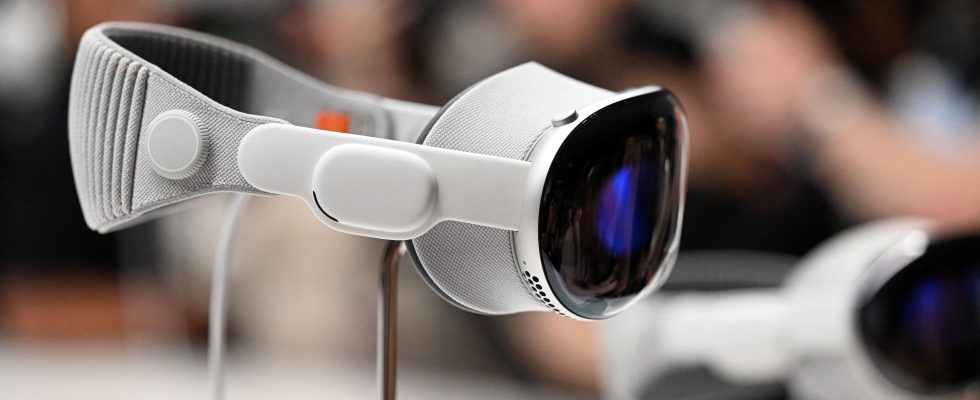Apple kicked off its Worldwide Developers Conference (WWDC), during which was presented its first mixed reality headset, both virtual (VR) and augmented (AR), developed in secret for many years in its Silicon Valley laboratories. This top-of-the-range model that can be controlled by fingers and voice, called “Vision Pro”, will sell for nearly $3,500 a piece by the time it leaves the factory, scheduled for 2024. Apple is entering a market already well occupied by Sony , Samsung, Microsoft, HTC, Oppo and of course Meta. The firm led by Mark Zuckerberg is already on the third version of its Meta Questannounced a few days ago in anticipation of future announcements from the apple brand.
Meta, again, has above all tried in recent years to develop, in parallel with the marketing of its helmets, a vision of what virtual reality could be, the highest level of immersion possible. It is the famousmetaverse“, a concept borrowed from the author Neal Stephenson and characterized by a network of virtual worlds, if possible interconnected. A 3.0 life with on the eyes what looks like ski goggles with screens. And in this universe, moments of meetings with friends, shopping, learning, work too – the goal of “Workrooms”. Mark Zuckerberg’s company even took its new name, “Meta”, from it, replacing Facebook to stick to this bet. of virtuality during the Covid-19 crisis had almost made it natural.
It’s not that much anymore. Another boom, that of generative artificial intelligence, quickly eclipsed the expectations of the general public around this technology. It must be said that in the meantime, the experiments have turned out to be disappointing. Meta suffered in 2022 more than 4 billion dollars in losses within its section dedicated to immersion. The helmets did not sell. Only 8.5 million units last year, well below expectations. “Meta missed its mark thinking of creating a powerful ecosystem around it and becoming the spearhead of a movement. The mayonnaise did not take”, summarizes the economist Vincent Lorphelin, president of the think tank Controv3rse dedicated to the metaverse as well as Web3. So what is Apple doing in this quagmire?
An army of developers
Tim Cook did not use the term “metaverse” on Monday, preferring that of “space computer”. The boss of Apple has especially worked hard to present the so-called “increased” uses of his helmet. That is, by allowing the user to see the environment around them (using cameras), while using traditional Apple applications, such as video calls, messaging, and many others. A way to lay the first milestones towards a more total immersion in the future. It is already possible to “scan” his face in order to reproduce it in 3D as an avatar, in the helmet. “This is just the beginning,” Cook warned.
Due to its unaffordable price and the shape of its helmet – still far from the glasses that Apple dreams of, more mobile, less heavy and less restrictive – the device should therefore be partly intended for professional use. The Cupertino teams have also insisted a lot on the productivity gains made possible by his new machine. “Since the failure of the metaverse of Meta, interesting uses of mixed reality have persisted in industry, health or training. The manufacturer Renault, for example, uses VR to train its painters, by reproducing their gestures while avoiding the associated costs. In Walmart supermarkets, in the United States, they prepare future recruits for customers. Museums also use them for breathtaking exhibitions where you immerse yourself in the pyramids of Kheops or Notre-Dame de Paris”, lists the entrepreneur Morgane Soulier, author of the book to be published Beyond the metaverse (Grasset, 2023). A reality, on the ground, which had to convince Apple. Information from Mark Gurman, Bloomberg, also report a goal of one million sales in its first year of launch, by early 2024. That is 232 times less than iPhones last year. Apple’s intentions are modest. For now at least.
Because the conference of this June 5 – as its name indicates it – was addressed to the developers. In 2022, during the previous edition, there were 34 million affiliated with Apple. This army surely holds the key to the equation for Apple: “The one leading to “killer” applications, the “killer app” which will give reasons to the general public to buy a mixed reality headset”, estimates Vincent Lorphelin. Like ChatGPT for AI. A social network? A game ? No one has found the magic ingredient yet. Apple presented this Monday the operating system (OS) Vision, to provide the possible next nuggets to this helmet. If this path is likely to be long, Apple assumes, unlike Meta, to seek the right formula before deploying the entire marketing armada.
The largest market capitalization in the world leaves with strong assets. Apple is renowned for contributing to technological breakthroughs, with the iPhone 15 years ago being one of the best examples. This innovation has resulted in a rich ecosystem, which is immediately embedded in the headset: a host of games, video calls by Facetime, content on its Apple TV + channel. A partnership with Disney + was added on Monday to provide more video content. Finally, the apple brand has a considerable financial strike force to hatch the good hens with the golden eggs. In 2022, developers around the world have thus generated more than 1,000 billion dollars thanks to their applications present on the App Store, integrated into the company’s phones, tablets or watches. At the same time, Apple took in some $78 billion in commissions. Not far from 20% of its planetary income. A “win-win” agreement that Apple would like to reiterate with Vision OS. And who himself would have nothing virtual.
